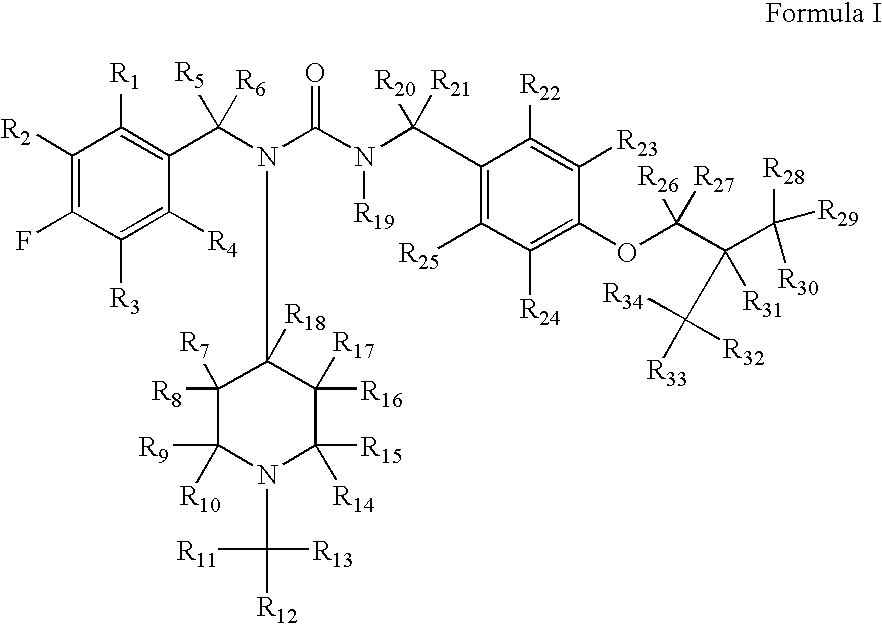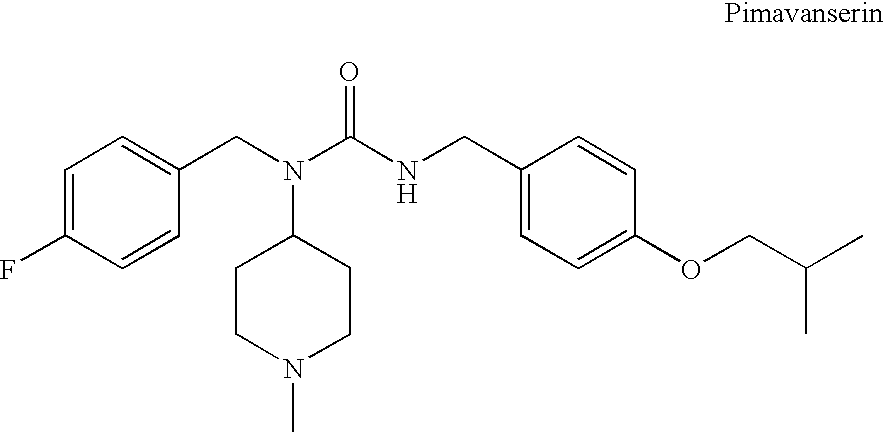Substituted ureas
a technology of urea and receptor, which is applied in the direction of biocide, cardiovascular disorder, drug composition, etc., can solve the problems of hepato- and other toxicities, shorten the half-life of quinone methides, and produce metabolites, so as to improve the clinical
- Summary
- Abstract
- Description
- Claims
- Application Information
AI Technical Summary
Benefits of technology
Problems solved by technology
Method used
Image
Examples
example 1
1-(4-Fluorobenzyl)-3-(4-isobutoxybenzyl)-1-(1-methylpiperidin-4-yl)urea hemi-tartrate
Step 1
[0222]
[0223](4-Fluoro-benzyl)-(1-methyl-piperidin-4-yl)-amine: To a solution of 4-fluorobenzylamine (3.67 g, 29.3 mmol) and N-methyl-piperidine-4-one (3.48 g, 30.7 mmol) in methanol (30 mL) was added triacetoxyborohydride (6.5 g, 30.6 mmol) within 30 minutes at 0° C. The reaction mixture was stirred at ambient temperature for another 2 hours. After comsumption of the amine monitored by thin layer chromatography (DCM / MeOH, 9 / 1, v / v), 30 mL of 10% sodium hydroxide solution was added. The reaction mixture was concentrated in vacuo and the residue was subjected to standard extractive work up. Removal of the solvent affored the title compound as an oil (6 g, 92%). 1H NMR (300 MHz, CDCl3) δ 7.75 (m, 2H), 7.10 (m, 2H), 5.88 (br. s, 1H), 3.96 (m, 1H), 2.81 (m, 2H), 2.29 (s, 3H), 2.10-2.18 (m, 4H), 1.54 (m, 2H); LC-MS, m / z=223, (M+H).
Step 2
[0224]
[0225]Methyl 2-(4-isobutoxyphenyl)acetate: A mixture of m...
example 2
d2-1-(4-Fluorobenzyl)-3-(4-isobutoxybenzyl)-1-(1-methylpiperidin-4-yl)urea hemi-tartrate
Step 1
[0234]
[0235]d2-2-methylpropan-1-ol: To a suspension of lithium aluminum deuteride (1.9 g, 45 mmol) anhydrous ether (15 mL) was added dropwise methyl isobutyrate (3.06 g, 30 mmol) at 0° C. The reaction mixture was stirred at 0° C. for 16 hours. The reaction mixture was filtered and the solid was further washed with ether (30 mL). The filtrate was dried over anhydrous sodium sulfate, filtered and concentrated in vacuo to afford a clear oil (526 mg, 23% yield) which was used directly in next step without further purification.
Step 2
[0236]
[0237]d2-Methyl 2-(4-isobutoxyphenyl)acetate: To a mixture of d2-2-methylpropan-1-ol (1.53 g, 20 mmol) and diisopropyl azodicarboxylate (4.4 mL, 22 mmol) in tetrahydrofuran (10 mL) was added dropwise to a solution of triphenylphosphine (5.77 g, 22 mmol) and 2-(4-hydroxyphenyl)acetate (3.32 g, 20 mmol) in tetrahydrofuran (10 mL) at 0° C. The reaction mixture was...
example 3
d9-1-(4-Fluorobenzyl)-3-(4-isobutoxybenzyl)-1-(1-methylpiperidin-4-yl)urea hemi-tartrate
Step 1
[0246]
[0247]d4-2-(4-Isobutoxyphenyl)acetic acid: This procedure was carried out as described in Example 2, Step 3, by replacing methanol with d4-methanol. Yield: 450 mg, 60%. 1H NMR (300 MHz, CD3OD) δ 7.24 (d, J=7.8 Hz, 2H), 6.85 (d, J=7.8 Hz, 2H), 2.03 (m, 1H), 103 (d, J=6.9 Hz, 6H); LC-MS, m / z=211.2 (M−H).
Step 2
[0248]
[0249]d4-1-Isobutoxy-4-isocyanatomethyl-benzene: This procedure was carried out as described in Example 2, Step 4, by replacing d2-2-(4-isobutoxyphenyl)acetic acid with d4-2-(4-isobutoxyphenyl)acetic acid. Yield: 582 mg. Used directly in next step without further purification.
Step 3
[0250]
[0251]1-N-tert-Butoxycarbonyl-4-(4-fluorobenzamido)piperidine: To a solution of 1-N-tert-butoxycarbonyl-4-aminopiperidine (430 mg, 2.4 mmol) in dichloromethane (30 mL) was added 4-fluorobenzyl chloride (0.26 mL) at 0° C. The reaction mixture was stirred at ambient temperature for 1 hour and s...
PUM
| Property | Measurement | Unit |
|---|---|---|
| Fraction | aaaaa | aaaaa |
| Fraction | aaaaa | aaaaa |
| Fraction | aaaaa | aaaaa |
Abstract
Description
Claims
Application Information
 Login to View More
Login to View More - R&D
- Intellectual Property
- Life Sciences
- Materials
- Tech Scout
- Unparalleled Data Quality
- Higher Quality Content
- 60% Fewer Hallucinations
Browse by: Latest US Patents, China's latest patents, Technical Efficacy Thesaurus, Application Domain, Technology Topic, Popular Technical Reports.
© 2025 PatSnap. All rights reserved.Legal|Privacy policy|Modern Slavery Act Transparency Statement|Sitemap|About US| Contact US: help@patsnap.com



